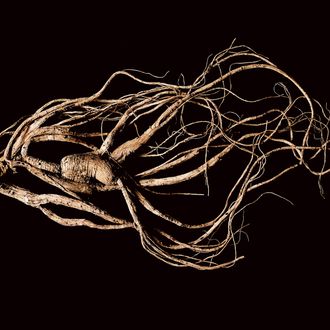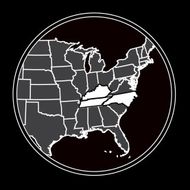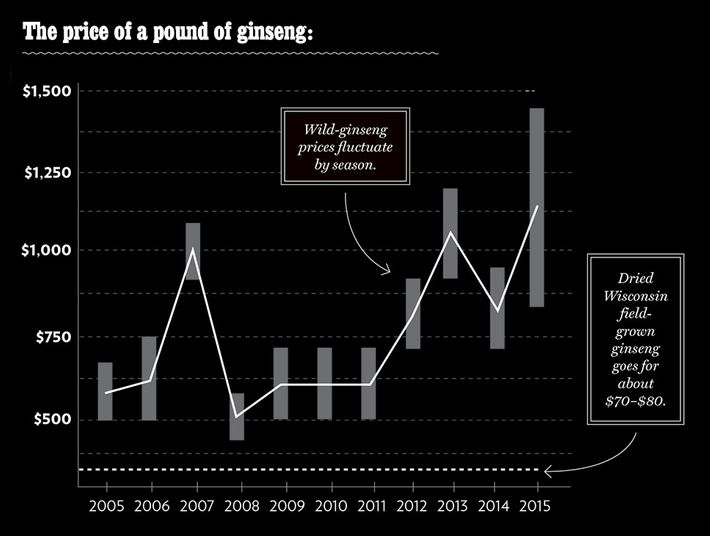
Somehow, this scrubby, tangled-looking root costs as much as a pretty good Swiss watch. Over the past decade, prices for wild ginseng — used both medically and superstitiously to treat an array of maladies — have been rising, and predictions for the 2015 harvest (beginning in September) indicate that they could reach as much as $1,400 per pound. Security cameras are scanning parklands; poaching is rampant; and diggers are starring in reality shows like Appalachian Outlaws and Smoky Mountain Money.
What exactly is ginseng?
The roots of American ginseng (Panax quinquefolius) and its close Asian cousin (Panax ginseng) both have long-standing reputations as folk medicines, especially when harvested from wild plants. Studies have suggested that ginsenosides, the active ingredients in ginseng, can boost immunity and mood, reduce some cancer risk, and lower blood-sugar levels in diabetics. The plant is also used, despite scant evidence, to treat many, many other maladies, from ADHD to breast cancer to schizophrenia to arthritis to (most of all) erectile dysfunction.

Where does it come from?
Wild ginseng grows mostly in the Appalachian and Ozark regions — often in public parks. The less domesticated the plant is, the more potent its enthusiasts believe it to be. There are four grades: wild, wild-simulated (planted but left alone), woods-grown (with pesticides and cultivation), and field-grown (farmed, mostly in Canada and Wisconsin).
Who buys it?
Ninety-five percent goes to Asia, mostly to buyers in China and Korea, who prize bulbous roots shaped like turnips that are typically found only in the wild. They will also pay a premium for a “man root” — a root shaped like a human figure with four limbs and, especially, a penis.
Other desirable qualities in a root besides a penis:
A longer neck with more rings and tight wrinkling, both of which are said to indicate potency. Also, no damage. Diggers must be very careful and can spend hours harvesting one plant. “Poke a hole in it with a shovel,” says Bob Beyfuss, America’s preeminent ginseng specialist, “and you’re screwed.” The most expensive roots are ancient. A Chinese buyer in 2007 paid $400,000 for a 300-year-old root weighing less than a pound. “The older it is,” Beyfuss explains, “the more energy it has absorbed.” (Never mind that research suggests we know next to nothing about ginsenosides — including what determines potency, or even how many there are.)

Why is it so expensive?
“The Chinese now have a lot more disposable income,” says Beyfuss. And they have harvested their wild ginseng into near extinction, which gives the American species cachet. (A surge in the supply of farmed ginseng — mostly from Canada, which has doubled its output since the 1990s — has kept those prices down.) The U.S. government is mulling trade controls to avoid a similar situation here. Already, wild-grown ginseng must be five years old to be legally harvested. But Beyfuss estimates that if the Feds try to protect wild ginseng by banning its sale, the black market will swallow the remainder up: “It would become extinct in five years with no incentive to replant.”
How are crops protected from poachers?
They’re hidden: “You don’t want to give yourself the problem of letting people know you have it,” says growing expert Michael Hunter. (Though some can’t resist the call of television.)
They’re watched: Foraging in most parks is illegal; many have installed 24/7 surveillance. Some growers guard the plants with dogs and automatic weapons.
They’re dyed: Agents from North Carolina’s agriculture department mark forbidden plants with a powder that glows under UV light. It’s reportedly helped convict 41 poachers.
Or they’re just faked: Counterfeit Wisconsin ginseng, made from lower-grade roots tagged with a knockoff trademark, has been catching on in China.
In the past five years, 53 poachers have been arrested in the Great Smoky Mountains, as well as 336 in Wisconsin.
*This article appears in the August 24, 2015 issue of New York Magazine.





























